How to Help Your Molting Chickens
Inside: There are several things chicken keepers can do to help their molting chickens when they start to lose feathers in the fall.
It’s that time of year when the feathers seem to fly. Literally. One day, you step into the coop, and you are greeted by chicken feathers everywhere.
Your first thought is that some critter got in the coop and had a chicken for dinner. So you do a headcount. After breathing a sigh of relief that everyone is safe and sound, you start to wonder what happened.
New backyard flock owners are often shocked by all the feathers the first time they see a molt in their adult chickens.
What Does It Mean When A Chicken Is Molting?
If you aren’t sure what molting is, it means that the chickens lose all their feathers and grow new ones. It’s usually a natural process that happens over time, not all at once.
The duration of a molt varies in each individual bird. Some chickens seem to molt slowly, losing a few feathers here and there, and you don’t even notice the feather loss. Others seem to molt very quickly and have bare patches of skin showing.
The average chicken will take between 6 to 12 weeks to complete her annual molt. However, some adult birds may take up to 4 months.
A few chickens that molt really fast may complete their full molt in just 3 – 4 weeks.
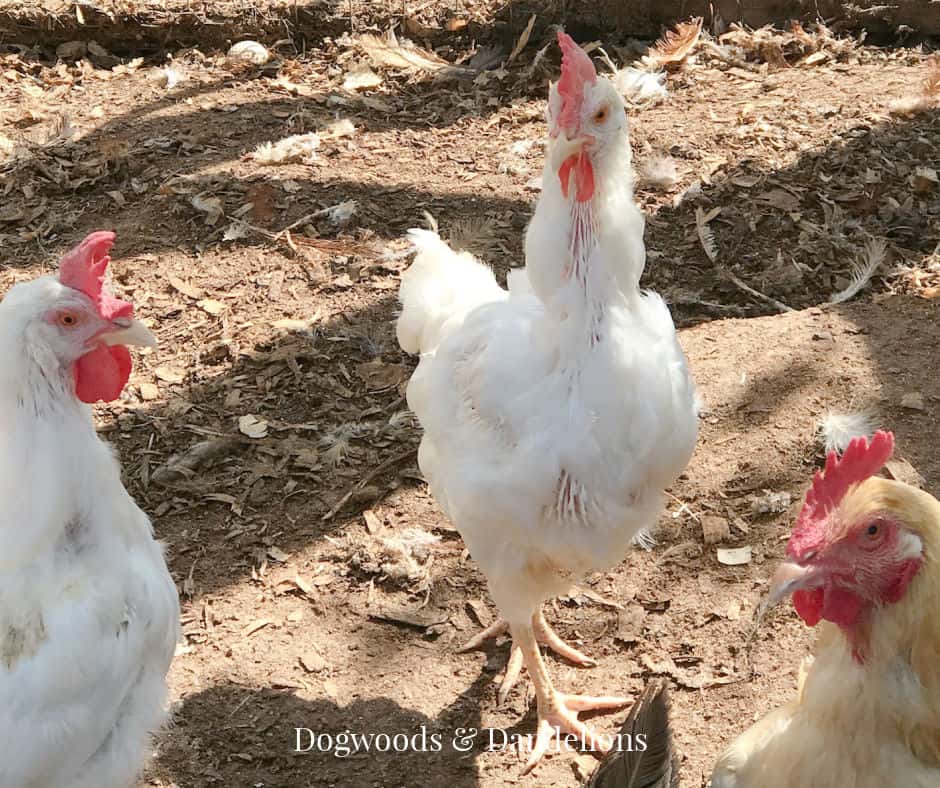
If you purchased baby chicks this year, they won’t go through a full molt. (They did a mini molt around one week of age and again between 7 to 12 weeks of age.)
However, you may still find that they lose a few feathers now and then. But in the fall of their second year, around 18 months of age, most chickens will lose all their old feathers and grow new ones.
Molting can be a stressful time for your birds. Feather regrowth takes a lot of energy. This lowers their immune system and can cause them to be more susceptible to illness and disease.
How can we help a molting bird through this stage? And what should we expect? Read on to find several ways to help your chickens get through their molt.
Want to learn more about raising backyard chicks? Get my free Chick-Raising Success Guide with 3 things you need to know to raise baby chicks (and none of the things you don’t!).
Affiliate Disclosure: Please note that some of the links in this article may be affiliate links and I may receive a small commission if you purchase something through a link. It will not change your cost. As an Amazon Associate, I earn from qualifying purchases. For more information, see my disclosures page.)
What Causes a Chicken to Lose Its Feathers
The yearly molt is triggered by several external factors such as the length of the day and the change in seasons. As the number of daylight hours begins to wane, this signals chickens to molt.
Generally, chickens will start their molt as we approach the shorter days in late summer or early fall.
However, a molt can occur at other times of the year. These atypical molts are generally caused by other factors such as stress, lack of water, changes in the chicken’s environment, or malnutrition.
The best way to prevent an atypical molt is to be sure your chickens have plenty of clean, fresh water and are fed a balanced layer feed. Try to avoid any unusual stressors such as moving coops or adding new members to the flock during this time.
What to Expect During a Molt & What Does a Molting Chicken Look Like?
When chickens lose feathers, they lose them in a specific order. Starting with their head and neck, then down their back and across their breasts, before finally losing their tail feathers.
Some chickens will molt quickly, replacing their feathers in three or four weeks. Others will take several months to grow new ones.
Occasionally, you may have a chicken molting so quickly that she (or he) has bald spots. My poor Ellie (below) looks pitiful but she is a fast molter.
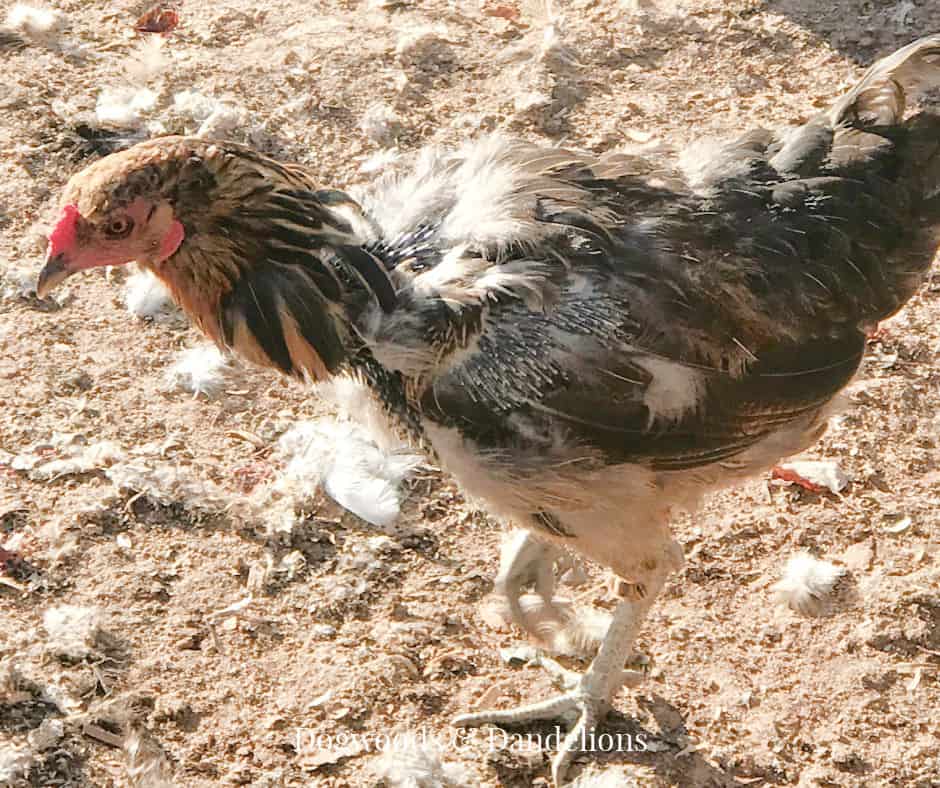
New feathers are called pin feathers and while they are growing they contain a blood vessel that carries blood to the growing feather.
If any of these get broken, they can bleed quite a bit. If this happens, you need to monitor your chickens closely, to ensure they don’t peck each other and cause sores, especially the chickens that are lowest on the pecking order.
Your favorite chickens may no longer enjoy being held either because the growing feathers are painful.
The new feathers are covered in a waxy coating that can be seen on emerging feathers. It will typically fall off on its own or be removed by the chicken while preening.
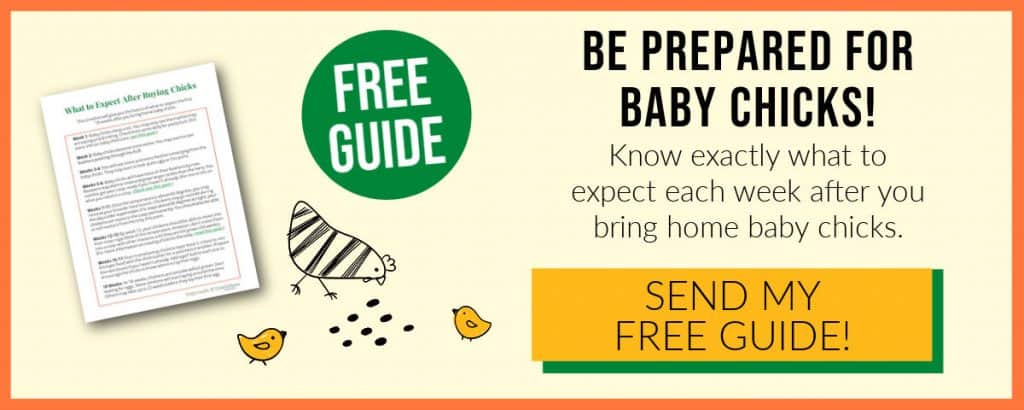
When chickens are growing feathers during a molt, it takes a lot of their energy. Most hens will lay fewer eggs, and some may stop completely. You will likely notice a drastic decrease in egg production from your flock during this period.
Most backyard chickens will not resume egg-laying until late February or early March when the days start to get longer again.
Read More: How to Freeze Eggs so that you can have your own fresh eggs while your chickens go through their molt.
How to Care For Your Molting Chickens
Molting is hard on your chickens. During a molt, chickens need extra protein in their diet. Changing their feed to a higher protein feed can help.
Many feed brands even offer specialized feed (like Nutrena Naturewise Feather Fixer) that can be purchased to increase their protein intake and help your birds through their molt.
You can also supplement their current feed with high protein treats such as mealworms or black oil sunflower seeds. Don’t let treats exceed 10% of the hen’s diet and refrain from giving them many low protein treats during this time.
Some people also give their flock chick starter since it contains a higher protein content. If you go this route, be sure to use an unmedicated feed.
Try not to stress your molting chickens. Stress can make the molting process longer for your chickens. Now is NOT the time to move them to a new home or introduce other chickens into the existing flock.
Occasionally, you may have a chicken or two that decides to molt in the dead of winter. To help them with their new feather growth during the cold weather, be sure that the coop is draft-free (but still well-ventilated) so they have a place to stay warm.
But please don’t put a chicken sweater on the poor thing. Growing new feathers is a painful process, and you will just be inflicting more pain by attempting to put a sweater on your molting chicken.
One interesting fact to note about molting chickens: Generally, the faster a hen molts, the better the egg layer she is. She replaces her worn feathers and gets back to the business of laying eggs. The best layers often tend to be late molters, waiting until the late fall months to shed their feathers.
So if you need to cull some chickens, watching how long they take to molt is a pretty good indicator of how well they lay. Slower molting chickens tend to lay fewer eggs, while good layers usually molt quickly. This can help you decide which ones to remove from the flock.
Once Your Chickens Have Finished Their Molt
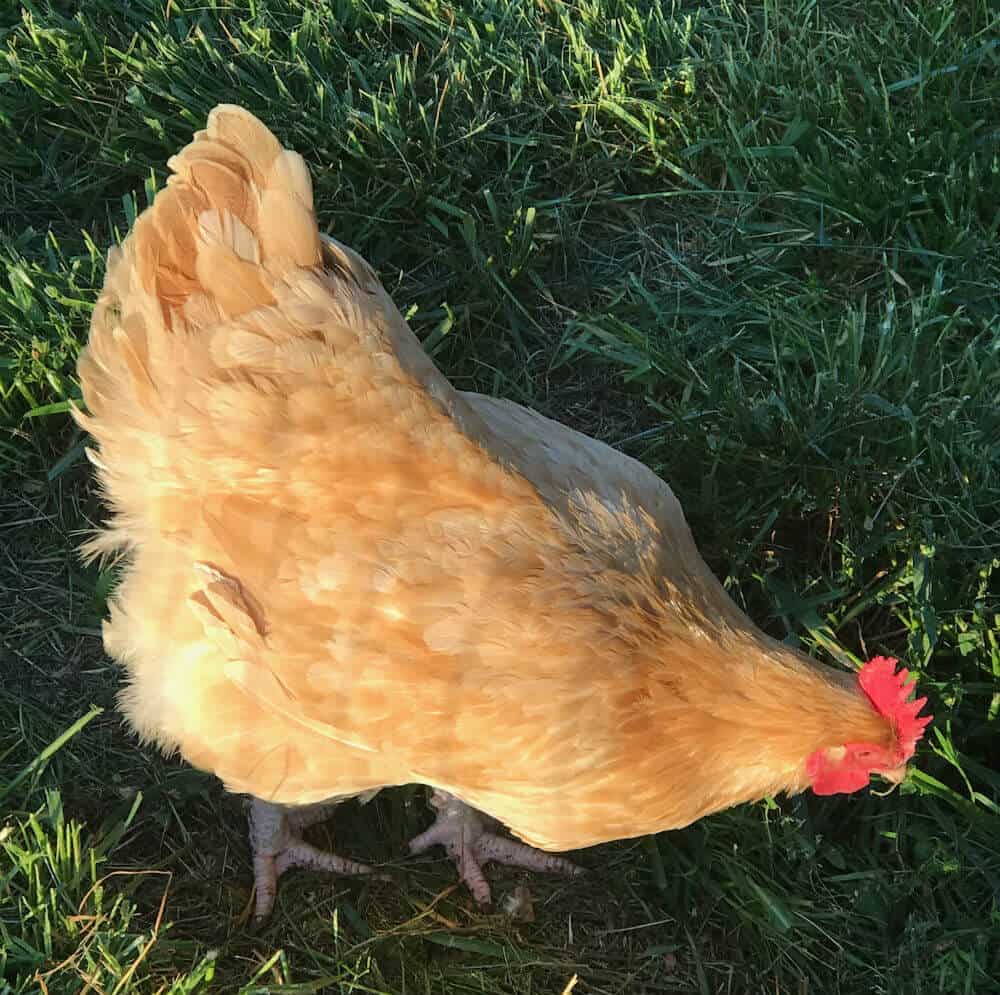
Once your chickens have finished molting, you may want to do a quick clean-up of the chicken coop. Remove as many feathers as possible, especially if you compost their droppings. (Feathers take quite a while to compost.)
And once the majority of the flock is done, you definitely want to return to their regular feed (as opposed to a high protein one). Too long on a high protein diet isn’t good for your chickens in the long term.
Remember, molting is a normal process. So with a little extra care and ensuring your chickens’ diet has enough protein, your flock should be able to get through their molt just fine. Before long, you’ll realize your flock has beautiful new plumage and looks a whole lot better with new feathers.
If you don’t have chickens yet but are thinking of getting them in the Spring, I have a whole series of posts on chicken keeping, including how to set up a brooder and how to care for baby chicks.
Want to learn more about raising backyard chicks? Get my free Chick-Raising Success Guide with 3 things you need to know to raise baby chicks (and none of the things you don’t!).

Meet Julie
I’m a farm girl born and bred in North Carolina. I’ve been growing a vegetable garden for over 20 years (and helping my Mom grow hers even longer). I’ve been raising chickens in my bathtub and backyard for 12+ years. I believe that homegrown food can be made simple. Let’s get started.
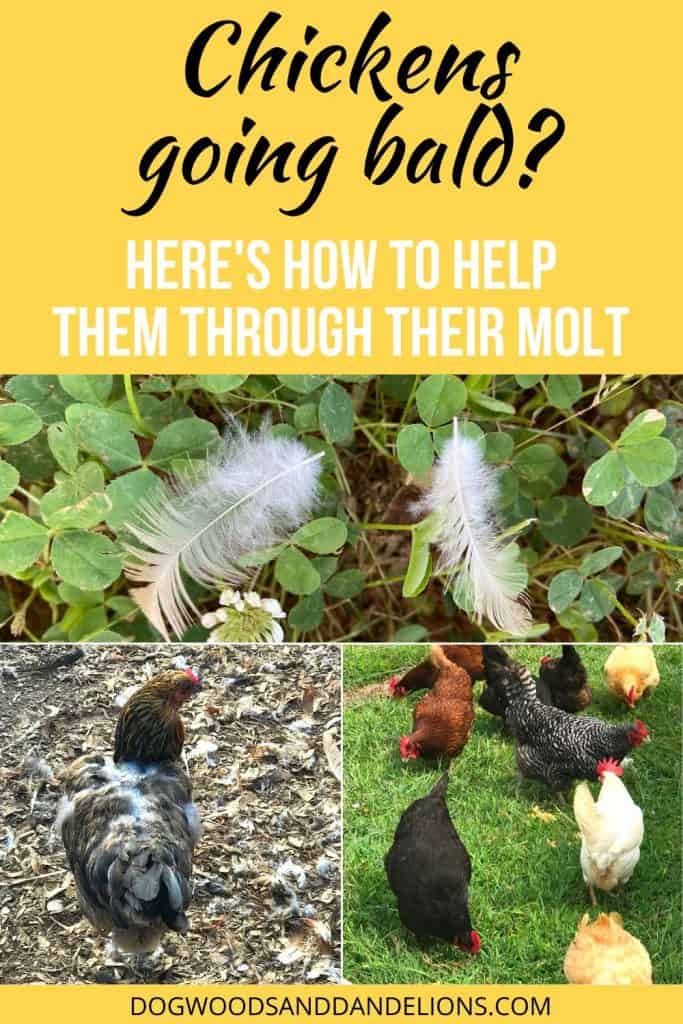
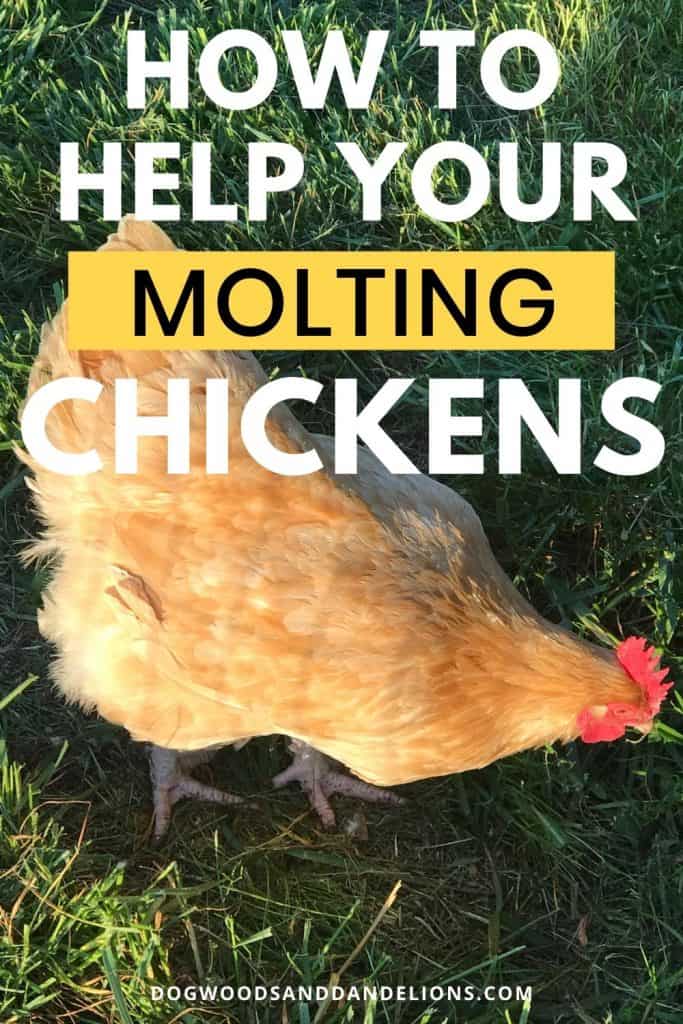
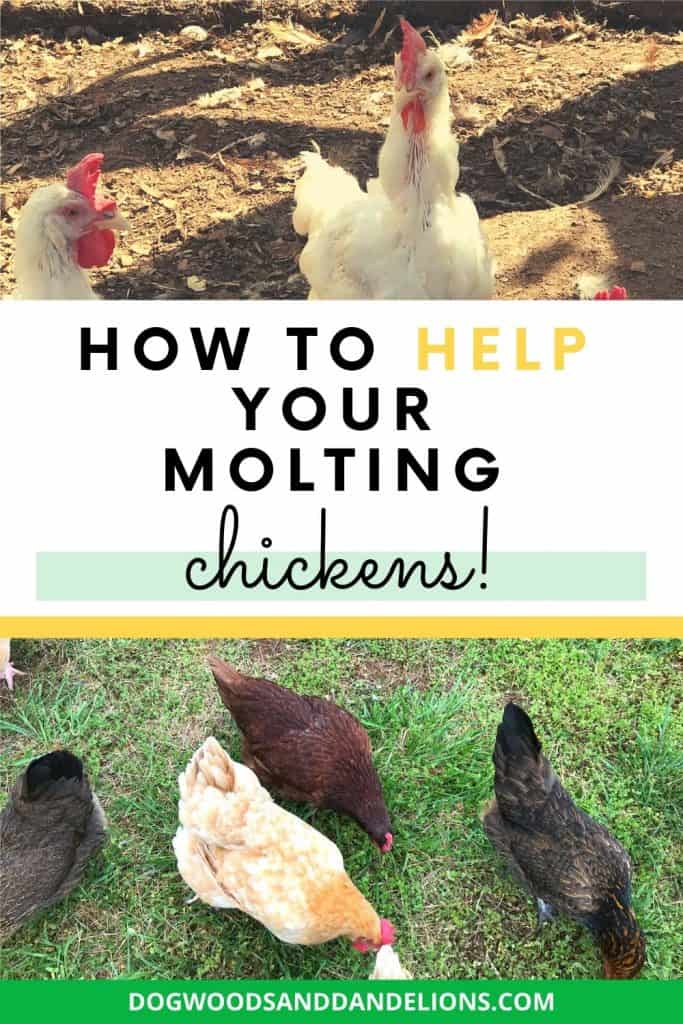

Really appreciate all your very informative articles.
I am a new/old chicken owner and my older 12 month old hens are doing amazing following so much of your advice. My question today is, I have four Pullets approx 12 weeks old who have met my older girls through a divided coop I would like to combine the flock but the Pullets are still on starter feed if I combine the flock whats to stop the Pullets from eating the layer feed which my big girls thrive on?
Thank you so much for your kind words.
There really isn’t much you can do to stop them from eating each other’s feed. (The layers may eat the pullets feed too.) If possible I would wait another month or so to combine them.
If that isn’t an option, I would purchase a non-medicated starter/grower feed for all your flock. It has a higher protein content that your 12 week old pullets need, but it shouldn’t hurt the older hens and may even help them if they are starting to molt. Put out a dish of oyster shell for the layers to get the additional calcium and you should be fine. Just keep a watch on the 4 new layers to be sure they aren’t being bullied by the older hens.
Oh man tha k you for this!! I have a hen who didn’t molt that much last year and she looks like someone just plucked all her feathers. She’s one of my favorites too!!
While she probably looks pitiful, she’s probably an excellent layer then. Hens that molt quickly tend to get back to egg laying the fastest. She should be just fine in a few weeks!